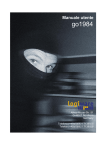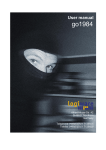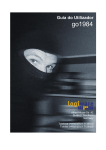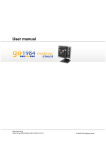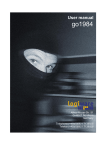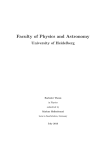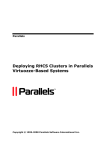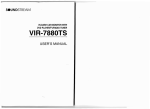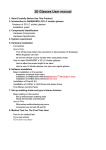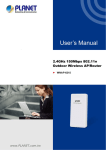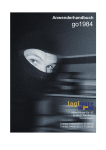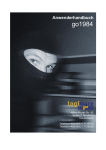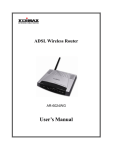Download go1984 User manual
Transcript
User manual
go1984
Alfred-Mozer-Str. 42
D-48527 Nordhorn
Germany
Telephone (+49)(0)5921 7139925
Telefax (+49)(0)5921 7139929
go1984
http://www.go1984.com
Alfred-Mozer-Str. 42
D-48527 Nordhorn
Germany
Telephone (+49)(0)5921 7139925
Telefax (+49)(0)5921 7139929
http://www.logiware.de
go1984 User manual
Contents
Table of Contents
1 Introduction
................................................................................................................................... 1
2 Editions ................................................................................................................................... 2
3 Installation
................................................................................................................................... 3
4 Launching...................................................................................................................................
the program
8
5 Entering ...................................................................................................................................
the license code
10
6 Basic setup
................................................................................................................................... 13
Adding a .........................................................................................................................................................
camera
IP camera
..................................................................................................................................................
PTZ camera
..................................................................................................................................................
Webcam ..................................................................................................................................................
(USB)
Capture card
..................................................................................................................................................
Recording.........................................................................................................................................................
Calculating
..................................................................................................................................................
memory requirements
Memory management
..................................................................................................................................................
Scene generation
..................................................................................................................................................
Pre-/Post..................................................................................................................................................
alarm
Access time
..................................................................................................................................................
period
Export ..................................................................................................................................................
Motion detection
.........................................................................................................................................................
Http event.........................................................................................................................................................
Notification
.........................................................................................................................................................
Sound ..................................................................................................................................................
E-mail ..................................................................................................................................................
FTP
..................................................................................................................................................
LAN-Broadcast
..................................................................................................................................................
External program
..................................................................................................................................................
ISDN
..................................................................................................................................................
Scheduler.........................................................................................................................................................
14
14
18
23
24
25
28
29
30
31
32
33
34
39
45
46
47
48
50
54
55
56
7 User management
................................................................................................................................... 60
8 Webserver
................................................................................................................................... 62
Configuration
.........................................................................................................................................................
Interface .........................................................................................................................................................
iPhone Client
.........................................................................................................................................................
J2ME Client
.........................................................................................................................................................
DynDNS .........................................................................................................................................................
Clustermode
.........................................................................................................................................................
63
65
68
70
73
76
9 Image Center
................................................................................................................................... 79
10 Additional
...................................................................................................................................
settings
83
Camera .........................................................................................................................................................
Startup settings
.........................................................................................................................................................
HTTP Proxy
.........................................................................................................................................................
SMTP server
.........................................................................................................................................................
configuration
Translation
.........................................................................................................................................................
83
86
87
88
90
11 Event management
................................................................................................................................... 91
12 Appendix................................................................................................................................... 95
POP3/SMTP-Server
.........................................................................................................................................................
95
13 Masthead................................................................................................................................... 96
© 2000-2009 logiware gmbh
1
1
go1984 User manual
Introduction
Introduction
go1984 is software designed for professional and hassle-free monitoring by closed circuit TV (CCTV). It
sets a new benchmark in the industry: it is simple to use, packed with features and available at an
affordable price.
go1984 features everything you'll ever need to carry out professional CCTV surveillance, including:
·
·
·
·
·
·
Live monitoring
Recording (timer-controlled, motion-triggered or permanent)
Control of PTZ cameras
Notification options: acoustic, by e-mail or by voice call via ISDN
Remote access via network or the Internet
Calendar functions
The software works as a so-called "hybrid system", which means it is capable of processing digital
network cameras as well as analog video sources via video servers or capture cards. Companies with
analog video technology can use the software to assist the "smart transition" to the digital world while
integrating their existing hardware. go1984 thus makes an important contribution to protecting your
investments.
go1984 supports the hardware of many well-known manufacturers such as, for instance: Axis, Sony,
JVC, Panasonic, Mobotix, Logitech, Intellinet and many others.
The following figure illustrates the connectivity options provided by go1984:
© 2000-2009 logiware gmbh
Editions
2
Editions
go1984 is available in various editions. The following figure highlights the differences.
© 2000-2009 logiware gmbh
2
3
3
go1984 User manual
Installation
Installation
Installing go1984 is a matter of minutes even for users unfamiliar with the program. An unregistered
version of the software can be tested for 30 days with all its functions. An uninstaller is included in the
download so that you can remove go1984 immediately from your computer if you are not happy with
the program.
To start the installation, click on the following icon:
First choose the language you want for the installation process.
You will now be taken step by step through the installation process for go1984. You can accept the
default settings and continue in the installation process by clicking on the "Next >" button where
applicable.
© 2000-2009 logiware gmbh
Installation
4
If you prefer to install to a different directory or hard-drive, please select the corresponding option in
the following dialog.
© 2000-2009 logiware gmbh
5
go1984 User manual
Installation
Then select the components to be installed. You can choose the go1984 client as well as go1984 (see “
LAN Broadcast” section).
© 2000-2009 logiware gmbh
Installation
6
The installation routine will automatically create an entry labeled go1984 in your Windows start menu. If
you prefer a different name, you can change it at this point.
All settings needed for the installation processes are now available. By clicking on the "Install" button,
the installation will be completed and the required files will be copied to your hard-drive.
© 2000-2009 logiware gmbh
7
go1984 User manual
Installation
The installation of go1984 has now been completed. The installation routine is closed when you click on
the "Finish" button. You can choose to have go1984 launched directly afterwards.
In the Enterprise edition go1984 can be installed as a service. To do this, you start the program on a
one-off basis via the command line using the parameter "-install".
A message will appear indicating that the service has been successfully installed.
© 2000-2009 logiware gmbh
Launching the program
4
Launching the program
After installing go1984, there are various ways to launch it.
1. Launch using the Windows quick start bar
2. Launch using the desktop
3. Launch using the start menu
Select: Start à All Programs à go1984 à go1984
© 2000-2009 logiware gmbh
8
9
go1984 User manual
Launching the program
4. Autostart
If you want go1984 to be launched automatically when your computer is switched on, please activate
the option shown in the following diagram. If you are going to run go1984 in service mode (see
"Installation" section), deactivate this option so that go1984 service will then be launched automatically.
Note:
Most Windows programs are shut down completely when you close the program window.
go1984 is only hidden and continues to run in the background.
While the program is running, the go1984 symbol is displayed in the task bar near the time. You can
use it to shut the program down completely or to bring it back to the foreground. Clicking on the icon
with the right mouse key will open the corresponding menu.
© 2000-2009 logiware gmbh
Entering the license code
5
10
Entering the license code
go1984 runs as a demo version after being installed. In order to make go1984 function without any
time or feature restrictions, you need to enter the activation data you purchased into the appropriate
fields.
© 2000-2009 logiware gmbh
11
go1984 User manual
Entering the license code
Please take care to transfer the data exactly as you received them by e-mail or on the license card. You
will sometimes find a numerical input for the name or place in the activation data. If this is the case,
enter the specified numerical sequence.
If activation fails, please check whether you entered the data correctly. In 99,9% of all cases, typing or
transcription errors are the reason for activation failing.
© 2000-2009 logiware gmbh
Entering the license code
12
If you have purchased a license extension or an update to a higher edition, click on “Input upgrade key”
to enter the new activation data.
Note:
You must always enter the data for the full version first. You can then input the update or
upgrade key after this (for instance, after reinstalling your operating system or moving to a
new system).
© 2000-2009 logiware gmbh
13
6
go1984 User manual
Basic setup
Basic setup
In order to use go1984, one or more image sources are required. The following sources can be used:
· IP cameras
· Capture cards and TV cards
· Webcams (USB)
This section explains how to integrate cameras or other image sources into go1984. It also provides
information on how to configure recording, on the integrated motion detection feature and on the
notification options. We'll be working on the basis of a "typical" case, for which the pre-defined,
automatic program settings are sufficient.
If you wish to make further changes or improvements to go1984, please refer to the section "Additional
settings".
© 2000-2009 logiware gmbh
Basic setup
6.1
Adding a camera
6.1.1
IP camera
14
To add an IP camera, select the entry "IP cameras" in the go1984 explorer.
You now have two options for adding a new camera.
1. Camera picture
A list is displayed showing you pictures of all the available cameras, arranged in alphabetical order. You
can use a filter to conveniently restrict the search for the model you want. You can use characters and
numerics in any combination. For instance, the text “allnet” will list all the cameras that include this
combination of letters in their name.
Similarly, a numeric combination such as “210” or an alphanumeric filter such as “210a” can be input as
search terms.
If you select the "Ptz" checkbox you can limit your search to cameras with PTZ support.
© 2000-2009 logiware gmbh
15
go1984 User manual
Basic setup
You then double-click on the picture of the camera model you want to add.
2. Selection list
If you click on the “Add camera” button a list appears of the supported camera providers you can
choose from.
You simply choose the model of camera you want from the list.
© 2000-2009 logiware gmbh
Basic setup
16
In both cases, the following dialog box appears.
You should set the following parameters in it:
Name
Give the camera a unique nickname which can be used for it in go1984.
IP
Enter the camera’s IP address or host name here. If you have not yet assigned the
camera an IP address, refer to the camera manufacturer’s documentation.
Port
If a camera port other than the default port “80” is being used, you can change this
here.
Username
If authentication is required to access the camera, enter your username here.
Password
Enter your password here for the authentication process mentioned above. Refer to
your camera manual for details of the default passwords.
Finally, click on “OK” to confirm your details.
© 2000-2009 logiware gmbh
17
go1984 User manual
Basic setup
The camera you've added will now appear in the branch "IP cameras" of the go1984 explorer. The basic
setup of the camera has now been concluded. go1984 has automatically activated motion detection and
recording for this image source. As standard, cameras only record when there is a detected motion. If
you want to record images permanently, simply deactivate the motion detection option by clicking on
the “Motion detection” option box.
Note:
In the case of IP cameras that do not support simultaneous MJPEG and MPEG4 (dual
streaming), or where only MPEG4 streaming is activated by default, MJPEG or Dual Streaming
must be specifically selected in the camera settings (e.g. Allnet, Intellinet).
The section "Additional settings" provides information on how to edit further camera parameters such as
resolution, frame refresh rates or panning.
© 2000-2009 logiware gmbh
Basic setup
6.1.2
18
PTZ camera
If the IP camera which has been added is a PTZ camera (PTZ = Pan/Tilt/Zoom), you can easily operate
this via go1984.
Note:
If the camera’s live image appears but you cannot use the PTZ control, check the settings for "Host",
"Port", "Username" and "Password" under “Video” à “PTZ settings” to see that they are correct.
© 2000-2009 logiware gmbh
19
go1984 User manual
Basic setup
There are different camera control options depending on the camera model:
1. Via the arrow keys
2. Via the slider
3. Via "click and drag"
Click on the button in the centre and hold the mouse button down. Now move the mouse crosshair
within the PTZ field to move the camera to the position you want, which also allows you to use the pan
and tilt functions comfortably:
© 2000-2009 logiware gmbh
Basic setup
20
4. Via "Ctrl" + mouse-click in the live image
If the live image is visible and the camera name highlighted, you can also control the camera using the
Ctrl key and clicking inside the live image. In order to control the camera zoom, go across the image
with the mouse and move the mouse scroll wheel. These functions are also supported in an image
center display.
5. Via "Area zoom"
If the camera being used supports an area a frame can be created in the image by holding the Ctrl key
down, which is then highlighted. You need to select the camera name again to do this. This function is
also supported in an image center display.
© 2000-2009 logiware gmbh
21
go1984 User manual
Basic setup
Preset-Positions
You can save up to 16 camera positions for each camera. To do this, simply click on the position you
want.
Then enter a position description:
The new position is now displayed in color and can be accessed by clicking on it.
© 2000-2009 logiware gmbh
Basic setup
22
If you want the position to be displayed at certain times, you can link it via a right-click to a scheduler
created beforehand. You can in fact link the position to any signal.
If you right-click on a saved position it can be deleted again:
Note:
Sometimes administrator rights are required to be able to save or delete positions for the
camera.
© 2000-2009 logiware gmbh
23
6.1.3
go1984 User manual
Basic setup
Webcam (USB)
In order to be able to use your USB webcam in go1984, first install all the necessary drivers according
to the camera manufacturer's instructions. Once the camera is available as a DirextX device in Windows,
you can integrate it into go1984. For this, you first need to activate DirectX support. To do so, select the
option as indicated in the diagram. At the next program launch, go1984 will search your computer for
available DirectX devices and display them under "DirectX" in the go1984 explorer.
You now have the option of editing certain parameters such as the frame rate or the resolution.
© 2000-2009 logiware gmbh
Basic setup
6.1.4
24
Capture card
Capture cards are physically installed into the PC and convert analog image signals into digital signals.
Start by installing the card in your computer and installing all required drivers as indicated by the card
manufacturer's instructions. Most single channel capture cards based on the BT878 chip can be used.
Usually, only the first channel of multichannel cards can be used in go1984. In addition, go1984
supports the following four channel cards:
· Spectra8 by ITuner
· Videum4400 by Winnov
After you've installed your capture card successfully, it will be available to you as a DirectX device. The
next steps are the same as in the description for webcams (USB).
© 2000-2009 logiware gmbh
25
6.2
go1984 User manual
Basic setup
Recording
Recordings are automatically sorted by month to the respective camera in the go1984 explorer. If you
wish to view the recordings, select the "Recordings" entry of the respective camera in the go1984
explorer. You'll be shown a list of all the months for which scenes are available.
Monthly overview
Selecting a month will take you to the monthly overview. Days are listed vertically, times of day
horizontally. Each scene is represented as a little red mark in this overview. Moving the mouse pointer
over the marks calls up a quick preview of the corresponding scene. You can open the selected scene for
viewing by double-clicking on it.
© 2000-2009 logiware gmbh
Basic setup
26
Daily overview
If you wish to view the recordings for a specific day, select the day in the go1984 explorer as described
below. You'll be provided with an overview over the scenes recorded on that day. Here, too, moving the
mouse pointer over a scene will display a preview. Open the selected scene for viewing by doubleclicking on it.
In addition, you have the option of changing the playback speed of the preview mode and of defining
the width of the preview scenes.
© 2000-2009 logiware gmbh
27
go1984 User manual
Basic setup
Scene playback
You have two different modes available when you come to play back individual scenes.
Loop mode:
the scene that is currently selected will be re-run at the end of the scene.
Endless mode:
all the scenes recorded on the camera are played back in sequence in chronological order.
© 2000-2009 logiware gmbh
Basic setup
6.2.1
28
Calculating memory requirements
One of the most frequently asked questions is: how much hard-drive space will the recordings use?
There's no simple answer to the question because many factors play a role. These include:
·
·
·
·
·
The number of cameras (AK)
The number of frames per second (FPS)
The image size (KB)
The amount of compression
Whether recording is permanent or motion-triggered
In order to get a rough idea of memory requirements in the case of permanent recording, use the
following rule of thumb: You can usually assume the image size (KB) to be about 25-30 kilobytes.
AK * FPS * KB = kilobytes/second
This will give you the approximate number of kilobytes needed per second recorded. Multiplying by
3600 gives you an idea of the number of kilobytes needed per hour.
Please note that go1984 uses intelligent ring storage management to contribute significantly to efficient
memory management. In many cases, it makes sense in any case to use motion-triggered recording,
which reduces memory requirements substantially.
© 2000-2009 logiware gmbh
29
6.2.2
go1984 User manual
Basic setup
Memory management
go1984 includes efficient ring storage. This enables you to optimize available hard-drive space allocation
to the cameras, thereby ensuring that there is always enough memory space available for new
recordings. go1984 is able to delete the oldest recordings automatically after the allotted memory has
been used up. You can also select individual recording directories per camera.
The following criteria specifically apply for automatically deleting scenes. If more than one criterion is
relevant, the first criterion to be met will apply in each case:
the used disk space exceeds
this value:
in this case, you can allocate each camera a disk space quota.
When this option is activated, the oldest scenes are automatically
deleted when the quota is exceeded.
the scene is older than:
when this option is activated the scenes for each camera are
automatically deleted when the scene is older than the duration
specified in days.
disk space is less than:
the oldest scenes are automatically deleted when a quota for the
remainder of the disk space is exceeded. This value applies across
all the cameras which are recording on the same partition/hard
drive and if changed, it is automatically set for all the cameras on
this partition/hard drive.
© 2000-2009 logiware gmbh
Basic setup
6.2.3
30
Scene generation
go1984 can aggregate recordings made during a certain interval to so-called scenes. This makes it
much easier to find them later. The concept used is quite simple. Any scene that has already begun will
be continued if less time than defined in the field "Time interval" has passed. If more time has passed, a
new scene is generated. You can also define that a new scene should be generated as soon as the scene
file becomes larger than the value entered into the field "File size" or if the current scene is longer than
the value entered into the field "Duration".
The following criteria specifically apply for generating scenes. Once again, if more than one criterion is
relevant, the first criterion to be met is decisive:
no motion was detected for
this time interval:
if the time between two recordings triggered by motion detection
is less than specified here, the scene already begun is continued.
But if this time is exceeded a new scene is generated.
The same applies if the recording is triggered by a signal other
than internal motion detection (e.g. by a camera’s digital input
signal or by an http event).
the size of the scene file is
greater than:
a new scene is generated if the current scene exceeds the size
specified here.
the duration of the scene is
longer than:
if the scene duration specified here is exceeded a new scene is
generated. If scenes are recorded by default only when there is a
detected motion, the scene generated in this case will usually
cover a longer period than specified under this point.
© 2000-2009 logiware gmbh
31
6.2.4
go1984 User manual
Basic setup
Pre-/Post alarm
Usually, motion-triggered recording begins the instant a motion has been detected. However, it is
sometimes desirable to extend the recording by a few seconds before or after the event. To do so,
simply enter the desired number of seconds into the appropriate fields and then activate the function
using the corresponding button. go1984 uses your computer's random access memory (RAM) for this
feature. In order to avoid too much memory being reserved, you have the option of restricting the size
to a maximum value.
© 2000-2009 logiware gmbh
Basic setup
6.2.5
32
Access time period
Access to the recordings can be limited individually per user in the user management. Among other
things, you can permit full access, no access, or access to a specified time period. This is where you can
define the time periods valid for this camera.
Afterwards, simply select which time periods are available for the user in the user management.
© 2000-2009 logiware gmbh
33
6.2.6
go1984 User manual
Basic setup
Export
Recordings are saved in a proprietary format. However, the scenes recorded may be exported in AVI
format or individual images in JPEG format.
When you are exporting to AVI format, you will be offered the codecs available on your system to
choose from when it comes to video compression.
© 2000-2009 logiware gmbh
Basic setup
6.3
34
Motion detection
go1984 includes high-performance motion detection based on an optimized image difference process.
When motion detection is triggered, the so-called "Motion" signal is activated for this camera. This
signal can be used, for instance, to begin recording, to launch an FTP upload or to trigger an alarm.
The image is split for this purpose into 8x8 pixel segments which are each analyzed for motion. This
means that with a resolution of 640x480 pixels, for instance, 4,800 segments must be analyzed for each
individual image.
The threshold specifies what the minimum percentage of segments needs to be where motion is
detected in relation to the whole image so that a motion is indicated. For instance, in the case of a VGA
resolution of 640x480 pixels with a threshold of 1.5%, the figure will be 72 segments.
You should reduce the threshold if you want the motion detection facility to be more sensitive.
Motion areas are highlighted in the live image with red squares. As soon as the actual value exceeds the
specified threshold, the motion signal is triggered. The specified threshold (yellow) and current actual
value (green or red) are graphically represented by two colored bars in the program to make
adjustments easier for you. The actual value bar changes from green to red if a motion has been
detected. The circle in the “Motion” field also turns red.
You'll be shown the live image from the camera, with motion areas being marked by red rectangles. As
soon as the actual value surpasses the specified limit value, the motion signal is triggered. The specified
limit value (yellow) and the current actual value (green or red) are graphically represented by two
colored bars in the program in order to make adjustment easier for you. The actual value bar changes
from green to red if a motion has been detected. The circle in the "Motion" field also lights up in red.
© 2000-2009 logiware gmbh
35
go1984 User manual
Basic setup
It often makes sense to exclude certain areas of the camera image from motion detection. In order to
do so, you can draw any kind of mask over the image. Various tools are available for doing so. The
mask is displayed on the screen transparently for control purposes. Grayed out areas will be excluded
from now on.
Tools for drawing masks:
Pen for freehand drawing of masks
Rectangle tool for drawing masks
Eraser for deleting masks
Show or hide camera image
Line width 1
Line width 2
Line width 3
Line width 4
Invert mask
Load mask
Save mask
Delete mask
© 2000-2009 logiware gmbh
Basic setup
36
For normal purposes, motion detection settings do not need to be adjusted more than described above.
If the default values don't work perfectly for your needs, you'll find additional setup options on the
"Properties" tab.
© 2000-2009 logiware gmbh
37
go1984 User manual
Basic setup
The analyzed segments are sorted in ascending order in the bar chart according to detected motion
intensity. The maximum motion share indicates which percentage is relevant to the analysis. The
segments before this are excluded.
If the motion intensity of individual segments (red bar) now exceeds the green line in the relevant area
(yellow), the detected motion is highlighted in the relevant segment (red rectangle in the live image).
The green line originates from the factors “Noise suppression” and "Max. motion share”.
The reduction in noise suppression along with the increase in the max. motion share therefore result in
a higher level of sensitivity in terms of motion detection.
© 2000-2009 logiware gmbh
Basic setup
38
You will also find the following set-up options:
Analyze only every xth frame
motion detection is highly processor-intensive due to the image
decompression required.
Delayed detection
delay in seconds until the motion signal is triggered. This may, for
instance, be a sensible option for an e-mail alert in order to send a
relevant image.
Idle signal after
duration in seconds until the idle signal is triggered. For further
information, refer to the “Event management” section.
Motion value is greater than
This control enables you to avoid motion detection being triggered
by rapid, extreme lighting changes such as the interior lighting
being switched on or auto-iris adjustment by cameras etc.
Brightness is less than
Some cameras tend to produce noisy pictures under bad lighting
conditions, which can lead to motion detection being triggered.
This control enables you to turn off motion detection for images
generated at less than the specified basic brightness.
Threshold: Automatic
go1984 always tries to provide the best settings for the segment
threshold independently.
Threshold: Manual
analysis of each individual segment without the above-mentioned
extended, adaptively operating settings being taken into
consideration for the segment threshold. This option is
recommended only in exceptional cases.
© 2000-2009 logiware gmbh
39
6.4
go1984 User manual
Basic setup
Http event
Many of the current network cameras or even external network-enabled motion detectors nowadays
offer integrated motion detection and the facility to notify third-party systems of any movement
detected via an http message.
In the Enterprise edition of go1984 the motion detection facility of these devices can be used via the
http event. This may be a particularly sensible solution on performance grounds where there are a large
number of cameras.
You will find this function under the IO-Manager. You can add a new event by clicking on the relevant
button.
Enter the name you want to give the event.
© 2000-2009 logiware gmbh
Basic setup
40
The new signal is now available and can be activated or deactivated via the shown URLs.
The other settings are now applied directly via the web interface of the camera or motion detector. Take
as an example the settings for an axis camera shown below.
First of all, the go1984 server is created as an “event server”.
© 2000-2009 logiware gmbh
41
go1984 User manual
Basic setup
You can check the connection directly using the “Test” button.
Events can now be defined accordingly at the start and end of the movement:
© 2000-2009 logiware gmbh
Basic setup
42
Enter the “On-URL” parameter under “User-defined parameters” for the event at the start of the motion:
name=my_event&active=1
Then add a “MotionEnd” event which will be triggered at the end of the motion. Enter the following
parameters for this event: name=my_event&active=0
© 2000-2009 logiware gmbh
43
go1984 User manual
Basic setup
Then you must link the recording in go1984, which is linked by default to go1984 motion detection, to
the http event.
If you are not going to continue using the go1984 motion detection function any more or as an alarm
function, for instance, you can now deactivate it.
© 2000-2009 logiware gmbh
Basic setup
Note:
Sometimes you need to still change the values for the pre- and post-alarm so that the
recorded scenes cover the overall period you want.
© 2000-2009 logiware gmbh
44
45
6.5
go1984 User manual
Basic setup
Notification
go1984 can use various channels to notify you in case of an alarm. They are:
·
·
·
·
·
·
Playing an audio file via a sound card
Sending an e-mail with or without an image attached
Uploading one or several images via FTP
Sending an image to the go1984 client via UDP Broadcast
Launching an external program
Calling a telephone number and playing an audio file (ISDN card required)
Note:
All notification types need to be activated first. Clicking on the options field of the respective
option switches on the corresponding function.
If the desired option is grayed out, there are some settings that must be provided beforehand because
the option makes no sense without them. For instance, the option "Telephone call" makes no sense if a
telephone number has not been provided.
© 2000-2009 logiware gmbh
Basic setup
6.5.1
46
Sound
go1984 can play a freely selectable audio file in .wav format via your sound card in case of a
notification. Simply choose the corresponding file using the dialog.
To prevent too many notifications from being sent, you can set a rest period. This means that only when
at least the specified time has elapsed since the last playback can the sound file be played again.
Please also refer to the general notes on activating notification functions in the section on notifications.
© 2000-2009 logiware gmbh
47
6.5.2
go1984 User manual
Basic setup
E-mail
In order to enable e-mail sending from go1984, a so-called SMTP server (see reference) first needs to
be specified. If this has already been done, you can continue here directly.
Select the entry "Notification" in the go1984 explorer. You can now enter one or several recipients
(separated by semicolons) into the field E-mail address. Adjust the subject line if you wish. The variable
"%cameraname%" is automatically replaced by the name of the camera triggering the alarm when an
e-mail is sent.
Once again you have the option to set a rest period which must elapse between sending two e-mails, by
clicking on the clock icon. Simply click on the clock icon and then set the rest period you want.
Please also refer to the general notes on activating notification functions in the section on notifications.
Note:
The Action button
is linked by default to the go1984 motion detection function. If you
want to send a meaningful image as an attachment when a movement is detected, you must
sometimes increase the “Delayed detection” value under “Motion detection” à “Settings”.
The delayed detection will obviously have an impact on recordings too. But you can balance out this
delay simply by increasing the pre-alarm value accordingly.
© 2000-2009 logiware gmbh
Basic setup
6.5.3
48
FTP
If you wish the images from a camera to be sent to an FTP server in addition to being stored locally,
complete the following dialog.
First, enter the login data for your FTP server:
FTP server
Domain name or IP of your FTP server, e.g. ftp.online.com
Port
FTP port, almost always "21"
FTP user ID
Username for logging on to the FTP server
FTP password
Password for logging on to the FTP server
FTP directory
FTP server subdirectory where you want the images to be saved
Passive mode
If your FTP server cannot be run in the active mode, select this option
Keep connection
After uploading an image, the connection to the FTP server is kept open. If
you prefer the connection to be shut, deactivate this option.
You can also choose to resize images before saving them on the FTP server. Activate this option and
define the new size of the image using the corresponding fields.
Finally, you can define under which names to save the file(s) on the FTP server:
Simple filename
The file name is the name you enter into the field
Datetime filename
The file name includes the time of day. The constant part of the file name
has to be enclosed in quotation marks. Formatting is carried out according
to the following key:
yyyy
Year
mm
Month
dd
Day
hh
Hour
nn
Minute
ss
Second
zzz
Millisecond
Rotating number
filename
Enter the beginning of the file name into the field. A number is
automatically added onto the end of the name; it is increased by one after
each successful upload. After the counter reaches the defined value, it is
reset to 1. Older images are then overwritten.
Upload as "*.tmp" and
rename if finished
If you have problems uploading the files to your ftp server, you can have
the images uploaded with the extension ".tmp" at first. After the upload
has been successfully completed, the files are renamed to the "real" file
name.
© 2000-2009 logiware gmbh
49
go1984 User manual
Basic setup
The Action button
is linked by default to the "NewImage" signal (see also “Event management”
section). This means that the FTP upload is activated every time a new camera image is generated. In
this case too you have the option to set a rest period by clicking on the clock icon. This means that only
when the period specified between two transmissions to your FTP server has elapsed can a new upload
operation be launched. This then allows you to have the FTP upload operation simply carried out at a set
interval.
Please also refer to the general notes on activating notification functions in the section on notifications.
© 2000-2009 logiware gmbh
Basic setup
6.5.4
50
LAN-Broadcast
In the event of an alarm, go1984 can notify any users on the LAN via UDP Broadcast. If the go1984
client has been installed and is active, users will be notified about the movement detected on a camera
via popup and/or an acoustic signal.
Note:
The go1984 client should not be confused with the go1984 desktop client. Unlike the latter, it
is not suitable for permanent live monitoring via one or more cameras or for recording
images from them.
You can install the go1984 client on another computer by running the go1984 setup and only ticking the
"go1984 Client" option box.
The broadcast client can then be launched via the Windows Start menu.
© 2000-2009 logiware gmbh
51
go1984 User manual
Basic setup
Now activate LAN Broadcast for the cameras you want.
You also again have the option here to set a rest period by clicking on the clock icon. This means that
only when at least the specified period between two broadcasts has elapsed can a new notification be
sent.
Please also refer to the general notes on activating notification functions in the section on notifications.
If a motion is detected you will be informed via popup from now on. The last images transmitted can be
replayed by clicking on the “Play” button.
© 2000-2009 logiware gmbh
Basic setup
52
You can also apply other settings on the broadcast client.
Popup on new image
go1984 client appears in front when any motion is detected
Startup minimized
go1984 client is minimized on start-up
Play sound on new image
Choose whether and with which sound file you would like to be
notified if a motion is detected
Notify again after
Minimum period which must elapse before the next time you are
notified
Number of buffered snapshots Number of buffered images (max. "100")
Select Skin
© 2000-2009 logiware gmbh
Choose one of the available skins
go1984 User manual
53
Basic setup
Note:
Most Windows programs are shut down completely when you close the program window. The
go1984 Client is only hidden and continues to run in the background.
While the program is running, the go1984 Client symbol is displayed in the task bar near the time. You
can use it to shut the program down completely or to bring it back to the foreground. Clicking on the
icon with the right mouse key will open the corresponding menu.
The following functions are also available.
Show
StatusBar
this displays/hides the status bar with additional information such as resolution,
notification time, image size in the bottom section of the go1984 client window
Show Toolbar
this displays/hides the go1984 client toolbar
Stretch
this expands the image in the visible area (stretches)
Setup ...
this opens the dialog box for advanced settings
Show
this brings the go1984 client to the front again
Hide
this minimizes the go1984 client
Exit
this exits the go1984 client
© 2000-2009 logiware gmbh
Basic setup
6.5.5
54
External program
go1984 offers you the option of launching an external program in case of a notification. In this case, the
image that triggered the notification can first be saved on the hard-drive. In this way, special tasks can
be carried out for which go1984 itself is not suitable.
To set up the feature, select the program you want to launch and the launch type. You can choose to
have the image that triggered the notification saved on the hard-drive first, and can freely define the
drive and the directory for this purpose.
Here, too, you have the option of defining a rest time by clicking on the clock symbol. A program is only
launched if the defined time has elapsed between two program launches.
Please also refer to the general notes on activating notification functions in the section on notifications.
© 2000-2009 logiware gmbh
55
6.5.6
go1984 User manual
Basic setup
ISDN
In case of an alarm, go1984 can make a telephone call using an existing ISDN card. Once the
connection is set up, the program plays a freely definable audio file to the person being called. Please
enter the telephone numbers using only numeric digits. Other signs or spaces can disrupt the function.
You can record your own audio files using the Windows "Audiorecorder". Please make sure you've set
the right format:
· PCM 8,000kHz; 16 Bit; Mono
In order to avoid being notified too often by calls, you can define a rest time that has to elapse between
calls. To do so, click on the clock icon and set the desired rest time on it.
Please also refer to the general notes on activating notification functions in the section on notifications.
© 2000-2009 logiware gmbh
Basic setup
6.6
56
Scheduler
go1984 provides the option of executing certain functions such as recording or notifying only at certain
times. You can define as many schedulers as you like, which can then be linked to the corresponding
functions. In order to create a new scheduler, select the option "Scheduler" in the go1984 explorer.
You can give each scheduler a unique name.
Afterwards, define the active and inactive times for each day. Simply select the desired times using the
mouse (keep left mouse button pressed). The active part will be shaded in green. You can copy any
day's settings to a different day using drag & drop. Simply use the mouse to drag the name of the day
(Monday, Tuesday, etc.) to a different day. Furthermore, you have the possibility of saving the
completed scheduler to a file or loading it. This is a useful feature when setting up several similar
schedulers.
© 2000-2009 logiware gmbh
57
go1984 User manual
Basic setup
You can also use the scheduler to turn various camera functions on or off automatically. The mouse
pointer changes to the following symbol when held over linkable functions:
. Clicking with the right
mouse button opens the menu for creating and editing links. Use the "Event à Scheduler à ..." entry to
select one of the existing schedulers, which will then turn the selected function on or off.
© 2000-2009 logiware gmbh
Basic setup
58
Note:
If certain functions need to be active at exactly opposite times (in this case, for instance,
opening hours), you do not necessarily need to create an extra scheduler. If you right-click
again on a scheduler link you can reverse the scheduler.
© 2000-2009 logiware gmbh
59
go1984 User manual
Basic setup
Under the “Holiday planner” tab you have the option to define days that should be processed separately.
These definitions have a higher priority than specified week schedulers. In many countries public
holidays are already pre-determined and can be changed or removed as required. You can also add via
the calendar additional days for the current year or for each year.
Make sure that the holiday planner is not activated by default, as specified holidays will continue to be
ignored. You activate this function by selecting the “Active” checkbox.
© 2000-2009 logiware gmbh
User management
7
60
User management
User management allows you to allocate individual authorizations for access to the program interface,
the web interface, recordings, and PTZ camera control. Directly after installation, user management is
not activated, i.e. all functions are accessible without entering a username or password. Activate user
management by clicking on the corresponding option field.
After activating the user management, access is only allowed after entering a valid username. go1984
creates a predefined, non-deletable Administrator account which always owns all access rights. This
account can be used without a password at first. However, you should define a password as soon as
possible by editing the Administrator account.
Username
Password
: Administrator
: [blank]
© 2000-2009 logiware gmbh
go1984 User manual
61
User management
The "User" column displays all existing users. Use the three buttons to create, edit or delete users.
Please note that a newly created user has no rights by default. In order to edit a user's right, first select
the user. Afterwards, use the "Access rights" column to allow or deny the desired options. You can also
change several users' rights in a single step. To do so, first select the first user, then press the CTRLkey on your keyboard and hold it while selecting one or several users from the list.
Access rights are subdivided into the following areas:
Cameras
Access to live feed, PTZ control, recording period
General
Deletion of scenes
Treeview
Access to IO functions, webserver settings, camera settings
Web
Access to the different browser views
Don't forget to save the edited settings using the "Save" button.
Note:
If new cameras are integrated after a user is created, the right to access the cameras must
be granted explicitly to the user that has been previously created.
© 2000-2009 logiware gmbh
Webserver
8
62
Webserver
go1984 provides an integrated webserver that is accessible from local networks and the Internet using
TCP/IP. The server makes it possible to access the live feed and recordings using the Internet Explorer.
Controlling PTZ cameras is also possible. What's makes the feature special are the HTML templates,
which permit a completely customizable design of appearances and functions. Use the examples
provided to adapt them to your own needs. You'll find the templates in the following directory:
<InstallDir>\Web
where <InstallDir> is the directory where go1984 was installed.
© 2000-2009 logiware gmbh
63
8.1
go1984 User manual
Webserver
Configuration
go1984 is delivered with predefined webs that can be called up using an Internet browser. Every web is
saved in its own subdirectory. The root web directory can be specified. In addition, the available
bandwidth can be limited. go1984 analyzes your computer's network configuration and displays all IP
addresses to which the webserver responds. It is also possible to make the computer accessible via the
Internet using a dynamic domain name.
© 2000-2009 logiware gmbh
Webserver
64
The web interface addresses the available cameras using a so-called index. This is a consecutive series
of numbers which you can use to define in which order the cameras are displayed on the web interface.
You can also view information regarding the currently active and inactive connections to the webserver.
For instance, the display indicates the session ID, the starting time, the time to automatic disconnection
in case of inactivity, the username and so on.
© 2000-2009 logiware gmbh
go1984 User manual
65
8.2
Webserver
Interface
Call up the web interface in your browser by using the following URL:
http://ip:port
Replace the variables as follows:
ip
by the IP address or domain name of the computer running go1984
port
by the port defined in the webserver configuration (default is 80)
You will then end up at the web server homepage where you can choose the web and transmission
quality that you want ("high" or "low"). You will also find the option to install the go1984 desktop client:
You can also access the web you want directly:
http://ip:port/web
Replace the variables as follows:
ip
by the IP address or domain name of the computer running go1984
port
by the port defined in the webserver configuration (default is 80)
web
by the directory name of the web. The following webs are predefined as examples:
·
·
·
·
·
·
java
tree
activex
javascript
pda
iPhone
© 2000-2009 logiware gmbh
Webserver
In the tree web you can also specify the camera or view you want directly:
...?view=x" (1=2x2, 2=3x3 etc.) or ...?camera=cameraname
The complete URL could look something like this:
The web interface shown in the diagram will then be displayed in your browser.
© 2000-2009 logiware gmbh
66
67
go1984 User manual
Webserver
If you've activated the user management, you'll first be shown a login request requiring you to enter a
valid username and password.
Note:
In order for all example webs to run correctly, you may have to modify your browser's
security settings. If you have no Java Virtual Machine installed, you can download it free of
charge at the following URL:
http://www.java.com
If you wish to use ActiveX-based webs, allow the following security settings:
·
·
·
·
Run ActiveX elements which are safe for scripting
Run ActiveX PlugIns and controls
Download unsigned ActiveX controls
Active scripting
If you wish to use Java-based webs, allow the following security settings:
· Scripting of Java Applets
· Active scripting
© 2000-2009 logiware gmbh
Webserver
8.3
68
iPhone Client
The go1984 web server provides a special interface for the iPhone. This offers you the chance to access
the go1984 server via the go1984 iPhone client. You can also establish a connection to the go1984
server both via a WLAN and via GPRS/Edge. This provides you with access to live images from all the
cameras on the go1984 web server which you have the relevant access rights for.
Call up the web interface in your browser by using the following URL:
http://ip:port
Replace the variables as follows:
ip
by the IP address or domain name of the computer running go1984
port
by the port defined in the webserver configuration (default is 80)
To change camera, select one from the camera list.
© 2000-2009 logiware gmbh
69
go1984 User manual
Webserver
Each camera gives you access to the entire recordings archive. You can use this simply to browse
through the scenes available for a particular day or select another day. To help you find the relevant
scene quickly, a preview is displayed for each recording. When you select the scene you want it starts
playing.
If it is a PTZ camera you can insert transparent buttons next to the relevant camera so that you can
pan, tilt and zoom the camera via the touch-sensitive display.
© 2000-2009 logiware gmbh
Webserver
8.4
70
J2ME Client
You can also use a cellular phone with Java capability supporting the MIDP2.0 standard to access
go1984. More specifically, you can
· view motion-controlled live images
· switch between the different cameras
· control PTZ cameras
Your cellphone has to be configured in such a way that the computer on which go1984 is running is
accessible via the Internet. To this end, you can connect using the CSD, GPRS or UMTS standards. If
your cellphone is not pre-configured for Internet access, please refer to your cellphone's instruction
booklet for the correct settings or contact your network provider. In addition, the go1984 computer has
to be accessible via the Internet using a static Internet IP address or a dynamic domain name.
Install the go1984 applet according to your cellphone's instruction booklet. You'll find the required JAD/
JAR files in the following directory:
<InstallDir>\web\wap\ota\
<InstallDir> is the directory where go1984 was installed. You can launch the applet directly after
installing it. First open the settings dialog.
© 2000-2009 logiware gmbh
71
go1984 User manual
Webserver
The following fields need to be completed:
Host
IP address or dynamic hostname of your go1984 computer
Username
Username as defined in the user management
Password
Password as defined in the user management
Bandwidth
Maximum bandwidth in bytes/second
Startup
camera
[Optional] Name of the camera that is automatically displayed after the connection
has been set up
© 2000-2009 logiware gmbh
Webserver
72
After you've completed all fields and confirmed them, you can build up a connection to the go1984
server by pressing "Connect". The image from the camera is displayed. The connection to the server is
maintained. In order to minimize costs, a new image is only sent to the cellphone if a motion has been
detected. Press the "More" key to display a list of the available cameras to which you can also switch. If
the selected camera is a PTZ camera, you can control it using the numbers keys:
2
Up
8
Down
4
Left
6
Right
1
Zoom out
3
Zoom in
*
Preset mode on/off. When you press this key, the letter "P" is displayed at the bottom right of the
screen. You can now control predefined/preset positions of the PTZ camera using the numbers
keys 1…9. Press the * key again to resume manual control.
© 2000-2009 logiware gmbh
73
8.5
go1984 User manual
Webserver
DynDNS
In order to make go1984 accessible via the Internet, you need to have either a static Internet IP
address or a dynamic domain name. The latter can be set up free of charge using the DynDns.org
service. Use the following link to set up an account:
https://www.dyndns.org/account/create.html
Complete the selected fields to create an account. After submitting the form, you'll receive a
confirmation at the e-mail address you provided. Click on the link in the e-mail to confirm your account.
Now you can log onto the service using your username and password in order to set up a domain name.
Click on the "Services" link, then on "Dynamic DNS" and finally on "Get Started".
© 2000-2009 logiware gmbh
Webserver
74
All you need to do is complete the Hostname field. Choose a hostname that is easy to remember and
distinctive. If you like, you can select a different extension for your domain name using the drop-down
menu indicated. Ignore all the other fields and simply click on the [Add Host] button. If the hostname
you've chosen is no longer available, choose a different one.
© 2000-2009 logiware gmbh
75
go1984 User manual
Webserver
go1984 can now automatically update the domain name. Initiate the process by providing the domain
name you've chosen, your username and password, and by selecting the option "Automatically update
DynDNS Domain". Now you'll be able to access your computer from the Internet using the dynamic
domain name.
© 2000-2009 logiware gmbh
Webserver
8.6
76
Clustermode
In the Enterprise edition of go1984 any cameras that have been integrated on a remote computer into
another go1984 Standard, Pro or Enterprise version can be added as “cluster cameras”.
This offers benefits in terms of:
· Network load: images can only be transmitted when a motion is detected; the camera on the cluster
client is almost in standby mode
· Performance: it may also be sensible to set up a cluster system for load distribution. The cluster
server or servers will then take over motion detection while the cameras on a central cluster client are
brought together.
A new cluster camera is created on the cluster client in the same way as adding an IP camera. This
means that you select the “IP cameras” option in go1984 Explorer. Then choose the camera "go1984
Camera" from the selection list.
Now specify the IP address or host name under which the go1984 cluster server can be accessed.
The next step is for you to give the camera a unique nickname which can be used for it in go1984.
© 2000-2009 logiware gmbh
77
go1984 User manual
Webserver
If the user manager is active on the cluster server you must enter a valid username/password
combination for authentication.
You must then enter the name of the cluster server camera in the “Camera” field which you intend to
access. You can also determine via the “Motion” parameter whether images should be transmitted
permanently (Motion = "0") or only when motion is detected (Motion = "1"). If you intend to transmit
the image in a different resolution or compression level to that of the original image due to a small
amount of bandwidth being available, you can set this via the parameters "Width" and "Height" or
"CompressionLevel". A compression level of "100" corresponds to the image’s original quality.
© 2000-2009 logiware gmbh
Webserver
78
You can see in the screen below that no images are transmitted as long as there is no kind of movement
("0 fps"). The cluster camera is therefore almost in standby mode. The motion detection function can
now be deactivated. Then every relevant image transmitted is recorded.
Note:
A web server session is initiated on the cluster client for every active cluster camera. If the
cluster server being used is a Pro edition one, a maximum of two cameras can be operated in
this way. With a Standard edition server a maximum of one camera can be operated like this
(see “Editions” à "Webserver sessions").
© 2000-2009 logiware gmbh
79
9
go1984 User manual
Image Center
Image Center
The Image Center is a flexible tool for viewing one or several cameras on a screen. The camera
arrangement is controlled using so-called views. go1984 provides numerous templates suitable for
different resolutions.
First, define a view by selecting the appropriate one from the list of available templates. Double-clicking
on it creates a new view that you need to provide with a unique name.
© 2000-2009 logiware gmbh
Image Center
80
You'll now be shown the newly created view in the go1984 explorer, in which one or several
placeholders are defined which will be replaced by the camera images later on. To link a placeholder to
a camera, click on it using the right mouse button. This calls up a menu with a list of all available
cameras. Select a camera from the list. You also have the option of placing a graphic behind the entire
view.
© 2000-2009 logiware gmbh
81
go1984 User manual
Image Center
You can define as many views as you like, which can then be displayed simultaneously on various
monitors or sequentially on a single monitor. Next, select the "Screens" entry from the go1984 explorer
in order to generate such a representation. First, click on the "Create a new screen" button. A "Screen"
can contain one or more views. Use the button to select and add the desired views to the list of "Views
for this screen". If you've added several views, go1984 can automatically switch between them at
certain intervals.
You can modify additional settings such as "Position", "Keyboard shortcuts" or "Properties" using the
corresponding entries.
Clicking on the "Show" button displays the preset "Screen".
© 2000-2009 logiware gmbh
Image Center
82
Defining customized views
If the views supplied don’t match up with your expectations, you can add more templates in a simple
manner.
You will find the definitions for the views (*.ini) under the go1984 installation folder in the “Template”
directory. You can edit these using a simple text editor or you can add more vi
The definitions describe the following in detail:
[Size] size of the whole view
[No.]
numbering of the objects contained: these may be specifically
- "PaintBox" a placeholder for the camera image
- "PTZ"
a placeholder for the PTZ field for a controllable camera
Note:
The new template will only be available after you have restarted go1984.
© 2000-2009 logiware gmbh
83
10
10.1
go1984 User manual
Additional settings
Additional settings
Camera
In order to modify other camera settings, please select the camera in the go1984 explorer. You now
have the option of influencing image processing.
Note regarding IP cameras:
The
button carries out a special function. While it is activated, the original *.jpg image from the IP
cameras is used in go1984; modifications such as rotating, mirroring or adding text are not possible. In
this way, go1984 can run at its optimum performance level. Wherever possible, try to apply camera
settings in the camera itself which make further modifications by go1984 unnecessary. If your
camera is not able to do this, deactivate the
button and apply the settings in go1984.
© 2000-2009 logiware gmbh
Additional settings
84
If you want the image to be captioned, use the [Caption] tab. This function is also only available when
the
button is not activated.
Fit image to visible area (expand)
Maintain image proportions
Use original image from camera (for best performance)
Flip image horizontally
Flip image vertically
Rotate image by 90°
Rotate image by 180°
Rotate image by 270°
© 2000-2009 logiware gmbh
85
go1984 User manual
Additional settings
You set the image record pause using the following sliders. The default setting is 200 ms, i.e. 5 images
per second (fps). In order to avoid increasing the network load and memory requirements
unnecessarily, you should in this case set the actual value required rather than the highest possible
value. In most cases, using higher image refresh rates hardly results in scenes with greater information
content.
As with many other sliders, you also have the option here to specify for your own convenience the value
you want in an additional window which opens when you double-click on [Pause between two frames].
Some additional information about the camera is displayed at the bottom of the screen.
© 2000-2009 logiware gmbh
Additional settings
10.2
86
Startup settings
You can choose to launch go1984 minimized. In this case, the application will not be visible at first. Only
the little go1984 program icon will appear next to the system clock. Double-clicking on the icon will
open the application interface. As a further option, you can set go1984 to be launched automatically
when Windows is started. If you are operating go1984 in service mode (see "Installation" section),
deactivate this option as the go1984 service is then automatically started. If you don't like the selected
standard skin, you can choose a different one.
© 2000-2009 logiware gmbh
87
10.3
go1984 User manual
Additional settings
HTTP Proxy
If a proxy server is required for the HTTP protocol in your network, define the necessary settings here.
Ask your network administrator for the correct settings.
© 2000-2009 logiware gmbh
Additional settings
10.4
88
SMTP server configuration
In order to enable e-mail sending from go1984, a so-called SMTP server first needs to be entered; this
only has to be done once. Outgoing e-mails are sent to this server and ultimately to the recipient. Your
provider can supply you with the settings required to configure the SMTP server. Alternatively, you can
obtain the information from your e-mail program (Outlook, Outlook Express etc.). A list of the most
common servers is supplied in the appendix.
© 2000-2009 logiware gmbh
89
go1984 User manual
Additional settings
In most cases, it is sufficient to complete the fields shown in the diagram. If go1984 is still not able to
send e-mails, check the settings or test using the "POP3-before-SMTP" authentication method. To do so,
please complete the "POP3 access data" block.
© 2000-2009 logiware gmbh
Additional settings
10.5
90
Translation
It is possible to integrate new languages for the interface. The following table shows the available
languages.
If you wish to create a new language option, right-click on a free column in the table. Select an existing
language as a template. A dialog box appears requesting you to enter a name for the new language (e.
g. Spanish). Use the existing languages to translate terms line by line into the new language. After
completing the translation, the newly created language option is immediately available.
© 2000-2009 logiware gmbh
91
11
go1984 User manual
Event management
Event management
go1984 includes a highly flexible event management option, which permits go1984 to be individually
configured. Various input and output signals are available. These signals can be supplied to go1984 by
cameras, schedulers or plug-ins.
Every input signal can be linked to one or more actions. The most important signals are automatically
linked to standard actions after go1984 is installed. For instance, motion detection is linked to recording
and notifications of the respective camera. However, you have the choice of changing these links.
The following output signals (Actions) are available (depending on camera type):
Output1,
Output2, ...
This output signal can be used to switch a camera's digital output (if available) on or off. It can be used
for applications such as controlling a door-opener, for instance.
Note:
An IP camera’s digital inputs or outputs are not supplied as standard. They must be explicitly
activated when required, in other words, set from "0" to "1".
© 2000-2009 logiware gmbh
Event management
92
The following input signals (Events) are available:
Signal
is activated when...
Active
the camera is active, which means that the option box next to the “Video”
option is ticked.
Darkness
the brightness of the camera image is very low
(see Motion detection à Settings à "Brightness is less than").
Error
the camera reports an error or is not available.
Idle
no further motion has been detected for the value “Motion detection” à
“Settings” à “Delayed detection".
Input1,
Input2, ...
the camera's digital input is being closed.
Motiondetector
a movement is detected.
MotionOverload
the motion level is very high (see Motion detection à Settings à "Motion
value is greater than").
NewImage
a new image is transmitted from the camera.
PreRecording
pre-recording is active.
Recording
images are being recorded at that moment.
SceneActive
a new scene is recorded and the interval specified without movement
which must elapse before the next scene is generated (see “Scene
generation” à "No motion was detected for this time interval") has not yet
expired.
Scheduler
the scheduler is in the green range.
Http event
the http event is currently active.
© 2000-2009 logiware gmbh
93
go1984 User manual
Event management
The different input signals are grouped in the program's IO Manager. LEDs are depicted to the left of the
signals. The LEDs may indicate the following status:
Signal on
Signal off
Signal is deactivated and therefore not available (default setting for camera inputs and camera
outputs)
You can view the different signals from the cameras in the IO Manager under the "Event" entry. It also
shows you which signal has been linked to which action.
© 2000-2009 logiware gmbh
Event management
94
You can create links anywhere the mouse pointer changes to the following symbol:
Clicking on the icon with the right mouse key will open the links menu. The following example illustrates
the process.
Example:
An IP camera's digital input has been linked to a doorbell. Whenever a visitor rings the bell, the camera
is supposed to start recording. To set up this event, first choose a camera in the go1984 explorer and
then select the "Record" option.
The various settings available for go1984's recording function are shown. The Action button
is near
the bottom. The button is linked to go1984's internal motion detecting after installation. You can now
change this link, mapping it to the camera's digital input. Click on the button with the right mouse key
to open the menu. Afterwards, select "Input1" as an input signal, as shown in the diagram. After you've
defined this setting, the camera will start recording as soon as the contact at the camera's digital input
is closed.
Note:
Please note that a single input signal can also be linked to several different actions.
In the example above, for instance, you could have the same signal trigger e-mail notification in
addition to recording. Furthermore, a camera's signals are also available for all other cameras. In the
example, the input signal from a single camera could be used to control the recording function of all
cameras.
© 2000-2009 logiware gmbh
go1984 User manual
95
12
Appendix
12.1
POP3/SMTP-Server
Appendix
A list of the most common POP3/SMTP servers:
1und1
POP3-Server: pop.1und1.com
SMTP-Server: smtp.1und1.com
Pop-Kontoname: ptXXXXXX-XXX (Mailbox-Name)
ARCOR
POP3-Server: pop3.arcor.de
SMTP-Server: postman.arcor.de (mail.arcor.de)
Pop-Kontoname: Benutzername
E-PLUS
POP3-Server: mail.imail.de
SMTP-Server: mail.imail.de
Pop-Kontoname: Benutzername
FREENET
POP3-Server: pop3.freenet.de
SMTP-Server: mx.freenet.de
Pop-Kontoname: [email protected]
GMX
POP3-Server: pop.gmx.net
SMTP-Server: mail.gmx.net
Pop-Kontoname: Kunden-Nummer oder E-Mail
LYCOS
POP3-Server: pop.lycos.de
SMTP-Server: smtp.lycos.de
Pop-Kontoname: [email protected]
o2 Online
POP3-Server: pop.o2online.de
SMTP-Server: mail.o2online.de
Pop-Kontoname: [email protected]
RTL World
POP3-Server: pop3.rtlworld.de
SMTP-Server: smtp.rtlworld.de
Pop-Kontoname: Benutzername
Schlund
+Partner
POP3-Server: pop.kundenserver.de
SMTP-Server: auth.smtp.kundenserver.de
Pop-Kontoname: m1234567-1 (Mailbox-Name)
STRATO
POP3-Server: post.strato.de
SMTP-Server: post.strato.de
Pop-Kontoname: name%eigenedomain.de
T-ONLINE
POP3-Server: pop.t-online.de
SMTP-Server: mailto.t-online.de
Pop-Name: Anschlusskennung|T-Online-Nr.|[email protected]
T-ONLINE SMTP
POP3-Server: pop.t-online.de
SMTP-Server: smtprelay.t-online.de
Pop-Name: Anschlusskennung|T-Online-Nr.|[email protected]
TISCALI
POP3-Server: pop.tiscali.de
SMTP-Server: smtp.tiscali.de
Pop-Kontoname: Benutzername ohne '@tiscali.de'
VODAFONE
POP3-Server: pop.email.vodafone.de
SMTP-Server: smtp.email.vodafone.de
Pop-Kontoname: Tel-Nummer o. Alias|@vodafon.de
WEB.de
POP3-Server: pop3.web.de
SMTP-Server: smtp.web.de
Pop-Kontoname: Benutzername
YAHOO
POP3-Server: pop.mail.yahoo.de
SMTP-Server: smtp.mail.yahoo.de
Pop-Kontoname: E-Mail-Adresse ohne '@yahoo.de'
© 2000-2009 logiware gmbh
Masthead
13
96
Masthead
logiware gmbh
Alfred-Mozer-Str. 42
D-48527 Nordhorn
Germany
Telephone (+49)(0)5921 7139925
Telefax (+49)(0)5921 7139929
Internet : http://www.go1984.de
E-mail sales : [email protected]
E-mail support : [email protected]
All company and/or product names are trademarks and/or registered trademarks or brands of the
respective manufacturers. We reserve the right to make technical changes and assume no responsibility
for errors or omissions.
© 2000-2009 logiware gmbh



































































































